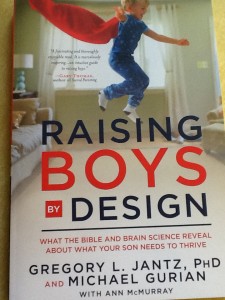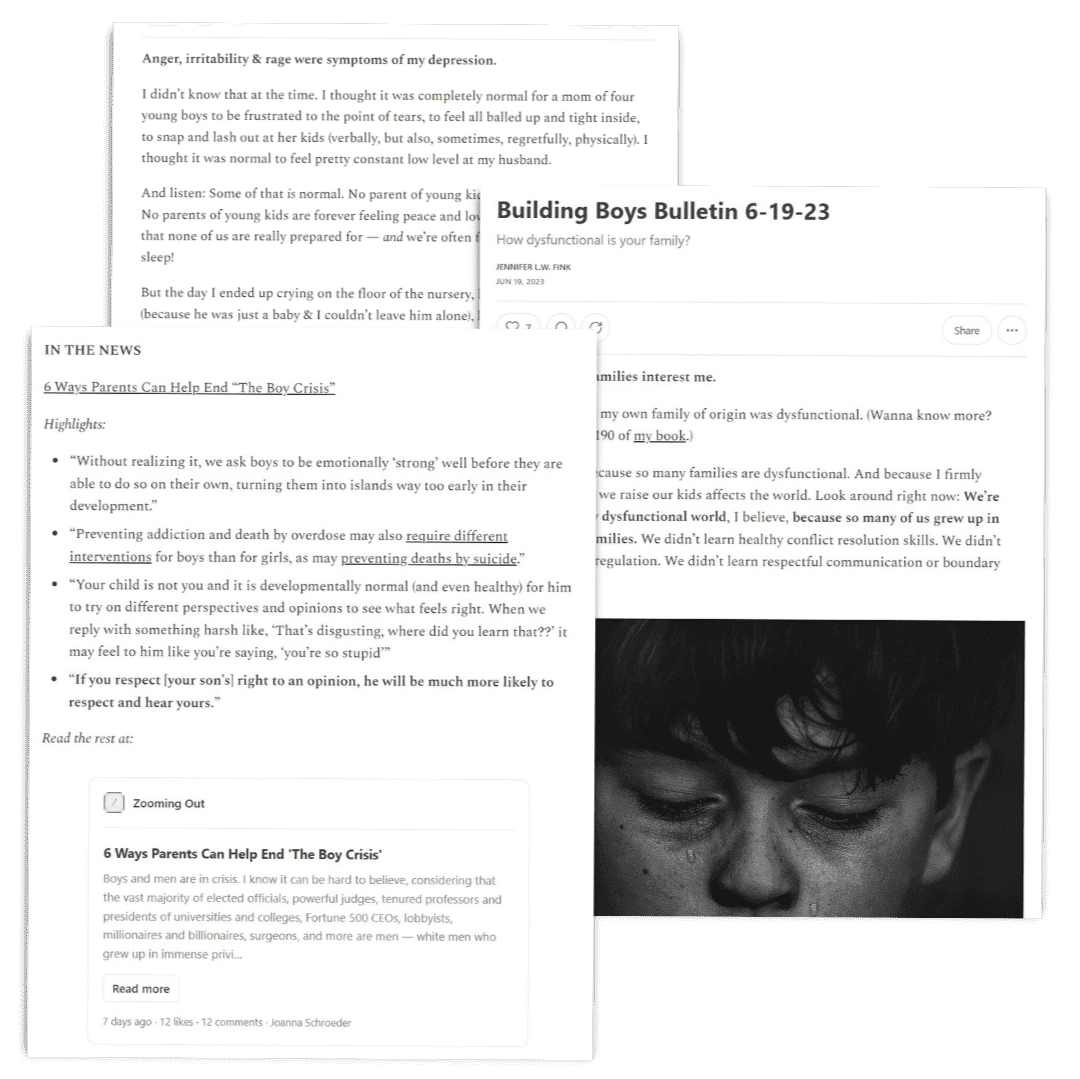
What do you think of Raising Boys by Design so far?
I plowed through Chapters 7, 8 & 9 – and promptly forgot to write about them last week. Ever have a week that just seemed to get away from you? Yeah, I had a feeling I’m not the only one!
Chapters 7 through 9 touch on some of parents’ greatest concerns regarding boys. Chapter 7, Protecting and Supporting a Boy’s Emotional Life, contradicts the prevailing cultural idea that boys are somehow less emotional than girls. Boys’ emotional lives and feelings are just as complex as girls’. The difference is in how boys process and express that emotion. Those differences are heavily influenced by both nature and nurture. Boys may come hard-wired to move their way through distress, but a culture that looks down on boys who cry is not exactly conducive to healthy emotional development. Gurian lists 8 ways to help boys process emotion, including the Action-Release method (favored by my 13-year-old, who instinctually wants to go out to run or play ball when he’s upset) and the Going-into-the-Cave method (currently favored by my 16-year-old).
The bottom line, Gurian and Jantz say, is to respect whatever method boys use to process their emotions. We can certainly guide boys towards the healthy expression of emotions – letting them know, for instance, that it’s OK to throw balls outside when they’re upset, but not OK to throw books in the house — but we can’t insist that boys handle their emotions in whatever manner is easiest for us. Some boys need time and space before they’re ready to talk about an upsetting incident or do whatever it takes to make it right. Attempting to force conversation or closure before the boy is ready is likely to lead to frustration all around.
I’ve learned, for instance, to let my son go when he storms out of the house in a moment of strong emotion. I know from past experience that he won’t go far, and that he’ll always return home. I know, from past experience, that he needs alone time to physically work through his emotions. And I know, from disastrous personal experience, that storming after him and insisting he return to the house right this minute is not useful or helpful; it’s downright frustrating and unproductive. It’s far more respectful to him – and productive for both of us – to let him have whatever time he needs, alone, before attempting to talk about the situation.
What about you? What have you learned about how your son processes emotion? How can you adapt your responses to your son to better accommodate his emotional needs?
I was scared of Chapter 8, Developing Healthy Sexuality in Boys and Young Men – not because I shy away from talking about sex and sexuality, but because I wasn’t sure how the topic would be handled in a book with a Christian bent. But I was pleasantly surprised. Jantz introduces the section about masturbation by sharing the story of a young Christian boy who was “tormented by guilt over episodes of masturbation,” and ultimately agrees with Dr. James Dobson, who said, “It is my opinion that masturbation is not much of an issue with God.”
That said, Raising Boys by Design assumes heterosexuality and emphasizes sex as a “God-blessed experience.” If you’re working with homosexual boys, or prefer to separate sex and religion, you might want to skip over parts of this chapter.
Don’t skip the whole thing, though, because Gurian and Jantz bring up some really good points, including the fact that boys should ideally learn about healthy sexuality from adult men. (Women, of course, can have a role, but boys truly are looking for other men to help guide them to adulthood.) Unfortunately, the book doesn’t address the fact that many adult men have skewed versions of sexuality. How can boys learn healthy sexuality when they’re surrounded by men who have unhealthy ideas about sexuality?
Do you struggle with how to address sexuality with your son? How are you dealing with issues such as the easy availability of porn?
Chapter 9, Helping Our Sons Do Their Best in School, is right up my alley. (I actually interviewed Gurian a few years ago for my Parents magazine article, Help Your Son Succeed in School.) As a mom of four boys, I am acutely aware of the fact that our current educational system is not a good match for most boys. Most boys learn best by doing. Most schools still emphasize quiet, sit-down learning. Most boys are innately curious and prefer to learn by following their interests. Most schools still tell boys (and girls) to learn a pre-determined set of facts at a pre-determined time. And despite the fact that boys (and girls) need movement, many schools have eliminated recess and cut back on gym time.
Instead of belaboring the problems that hinder boys’ education, though, Raising Boys by Design outlines steps parents can use to advocate for their sons. Take a look. I am seriously considering the idea of establishing a parent advocacy team, as described on page 146.
Is your son’s school a good fit for him? Why or why not? What are you doing to help your son and other boys succeed in school?
Next week: The last three chapters of Raising Boys by Design! I’ll also soon be interviewing the authors. What would you like me to ask them?







2 Responses
Thanks for the summary. I haven’t had a chance to read this on yet. I used to be a Michael Gurian junkie back when his first two books came out. It sounds like my Wave Riders workshop lines up with Chapter 7, so that’s encouraging. When you mentioned homosexuality it made me wonder what kind of mentoring resources are out their for GLBTQ boys as far as having someone to talk to about what health sexuality is for them. I can see how many men could feel even more awkward with that conversation than they already would be. There’s SO much unhealthy info EVERYWHERE (especially on the internet) for gay boys, and all sorts of people who would take advantage of them.
Great question! I’m going to reach out via social media and see what I can find out re mentoring resources for GLBTQ boys.